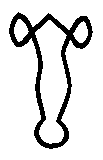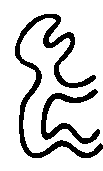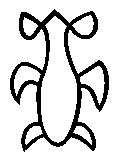Rongorongo
Rongorongo – pismo używane dawniej do zapisu prawdopodobnie języka rapanui używanego na Wyspie Wielkanocnej. Jedyny rdzenny systemem pisma na terenie całej Polinezji. Do czasów współczesnych zachowały się 23 lub 24 artefakty z napisami wyrytymi pismem rongorongo.
Opis
Pismo zawiera nieco ponad 600 zidentyfikowanych unikalnych znaków[1]. Znaki rongorongo zapisywane były systemem bustrofedonu odwracanego: czytanie rozpoczynano od lewego dolnego rogu w kierunku prawego i przy każdym końcu wersu odwracano tabliczkę o 180 stopni i kontynuowano czytanie od lewej do prawej[1]. Uważa się, że teksty pisane rongorongo są zapisane w języku rapanui[2].
Data powstania pisma jest nieznana, jedna z hipotez mówi, że powstało ono dopiero w wyniku kontaktu z europejskimi najeźdźcami, ale jest to mało prawdopodobne. Pierwsi europejscy odkrywcy wyspy w początku XVIII w. nie odnotowali znajomości pisma wśród miejscowej ludności. Pierwsze tablice zawierające teksty zanotowane pismem rongorongo zostały odkryte przypadkowo w 1869 r. przez biskupa Tahiti[1] – Florentina-Étienne’a „Tepano” Jaussena (1815–1891). Biskup otrzymał prezent w postaci ozdobnego sznura nawiniętego na kołowrotek, który został wykonany przez misjonarzy poddanych biskupowi z jednej z ozdobnych tablic pokrytych pismem rongorongo. Zaciekawiony tablicą, której użyto do wykonania kołowrotka, biskup wysłał list do miejscowych misjonarzy z prośbą o zgromadzenie jak największej ilości tablic oraz rozpoczął pierwsze próby tłumaczenia. Na wyspie znaleziono jednak tylko kilkanaście tablic[3]. Wówczas nikt nie potrafił odczytać pisma[1]. Większość zabytków tego pisma zaginęła. Przetrwało 23[4] lub 24 [5] tabliczek zapisanych rongorongo, w tym tabliczka z Berlina, pierwotnie zawierająca najdłuższy znany tekst w tym piśmie[5]. Łącznie na tych tabliczkach stwierdzono przeszło 12 tys. glifów[6]. Wszystkie tabliczki są wyryte w drewnie i znajdują się w kolekcjach muzealnych[5].
Pismo rongorongo było jedynym rdzennym systemem pisma na terenie całej Polinezji[1].
Według ustnej tradycji wyspiarzy istniały dwa pisma: powszechne – rongorongo i pismo tau ceremonialne, związane z kultem bogów czy przodków. Sztuka pisania i czytania była zarezerwowana dla specjalnie kształconych pieśniarzy tangata manu o te-rongo-rongo, czyli „ludzi-ptaków znających rongorongo”, i była wielkim przywilejem. Tradycyjna nazwa pisma kohau rongo-rongo oznaczała „łamać włócznie” lub „łamać słowa”. Wyraz rongo lub rong w językach polinezyjskich oznacza „słyszeć”, „wysłuchać”. Natomiast w kilku odmianach quechua z terenów Andów istnieje słowo rongo-go, które oznacza „wiadomość”.
Odszyfrowanie pisma
Spis znaków pisma rongorongo zaproponowany przez Pozdniakov & Pozdniakov (2007). Opisuje on 99,7% znaków użytych we wszystkich tekstach, z wyjątkiem rzadkich znaków wyrytych na tzw. lasce z Santiago.
| 01 | 02 | 03 | 04 | 05 | 06 | 07 | 08 | 09 | 10 | 14 | 15 | 16 |
|---|---|---|---|---|---|---|---|---|---|---|---|---|
| 22 | 25 | 27 | 28 | 34 | 38 | 41 | 44 | 46 | 47 | 50 | 52 | 53 |
| 59 | 60 | 61 | 62 | 63 | 66 | 67 | 69 | 70 | 71 | 74 | 76 | 901 |
| 91 | 95 | 99 | 200 | 240 | 280 | 380 | 400 | 530 | 660 | 700 | 720 | 730 |
Przypisy
- ↑ a b c d e Polak próbuje odczytać unikatowe pismo z Wyspy Wielkanocnej, naukawpolsce.pap.pl, 8 września 2017 [dostęp 2017-09-09].
- ↑ Wieczorek 2022 ↓, s. 47.
- ↑ Catherine and Michel Orliac, Des dieux regardent les étoiles. Za S. Fischer.
- ↑ Wieczorek i in. 2021 ↓, s. 1.
- ↑ a b c Wieczorek 2022 ↓, s. 47, 49.
- ↑ Wieczorek 2022 ↓, s. 50.
Bibliografia
- Thor Heyerdahl: Wyprawa Kon-Tiki. Warszawa: 1995. ISBN 83-85661-89-1.
- Thor Heyerdahl: Aku-Aku: tajemnica Wyspy Wielkanocnej. Warszawa: Muza, 1995.
- Rafał Wieczorek, Nowe światło na rongorongo – pismo Wyspy Wielkanocnej, „Archeologia żywa”, 4 (86), 2022, s. 46–51.
- Rafał M. Wieczorek i inni, The rongorongo tablet from Berlin and the time-depth of Easter Island’s writing system, „The Journal of Island and Coastal Archaeology”, 2021, s. 1–20, DOI: 10.1080/15564894.2021.1950874 (ang.).
Linki zewnętrzne
- Dr. Steven Roger Fischer, Easter Island’s “Rongorongo” Script. netaxs.com. [zarchiwizowane z tego adresu (2008-05-15)]. (ang.).
- Jacques B.M. Guy, RONGORONGO The Easter Island Tablets. netaxs.com. [zarchiwizowane z tego adresu (2008-05-09)]. (ang.).
- rapa-nui.net. Tradycja. Kultura. Współczesność. rapa-nui.net. [zarchiwizowane z tego adresu (2013-12-07)].
Media użyte na tej stronie
Tracing of rongorongo glyph 091. The "eyes" suggest it is a pictograph of an animal of some sort, perhaps a marine animal.
Tracing of rongorongo glyph 067. Thought to be a pictograph of the extinct Easter Island palm tree.
Tracing of rongorongo glyph 044.
Tracing of rongorongo glyph 050.
Tracing of rongorongo glyph 028.
Tracing of rongorongo glyph 014.
Tracing of rongorongo glyph 063. May replace the arm of another glyph.
Tracing of rongorongo glyph 038.
Tracing of rongorongo glyph 071.
Tracing of rongorongo glyph 061. An arm glyph.
Tracing of rongorongo glyph 010. An arm glyph, thought to be a pictograph of a bird's wing (compare
Tracing of rongorongo glyph 047. Thought to be a pictograph of a squid.
This image can't have copyright.
Tracing of rongorongo glyph 002, "lozenges". Variable number of lozenges (2-4), often with bulbs attached to the corners at either side or both sides, in various combinations that recall the letters of Braille. Proposed as a calculating device in the lunar calendar on Tablet C.
Tracing of rongorongo glyph 016.
Tracing of rongorongo glyph 025.
Tracing of rongorongo glyph 022.
Tracing of rongorongo glyph 069.
Tracing of rongorongo glyph 001. Thought to be a pictograph of a chief's staff, such as the Santiago Staff. Often apparently held by seated figure
The rongorongo script of Easter Island. A closeup of the verso of the Small Santiago Tablet, showing parts of lines 3 (bottom) to 7 (top). The glyphs of lines 3, 5, and 7 are right-side up, while those of lines 4 and 6 are up-side down.
Tracing of rongorongo glyph 066. Appears to be a pictograph of a marine animal.
Tracing of rongorongo glyph 046 that may resemble the eyes of the god Make-make.
Tracing of rongorongo glyph 530, thought to be a pictograph of a human figure, perhaps with some sort of headdress. Contrasts with
Tracing of rongorongo glyph 076. This is Knorozov's suspected patronymic marker and Fischer's "phallus".
Tracing of rongorongo glyph 007. Thought to be a pictograph of a reimiro.
Tracing of rongorongo glyph 400, thought to be an variant of a pictograph of a frigatebird. The beak is generally longer than this, though that variant is numbered 600 in Barthel's encoding; both are subsumed under 400 by Pozdniakov.
Tracing of rongorongo glyph 074. Suggested by Guy to be a pictograph of hanging fruit.
Tracing of rongorongo glyph 062. An arm glyph.
Tracing of rongorongo glyph 009.
Tracing of rongorongo glyph 070. Traditionally thought to be a ideograph of land (an island in the sea).
Tracing of rongorongo glyph 041. Thought to be a pictograph of a lunar crescent. It contrasts with crescent facing the opposite direction, which is much less common and plays a different role in the script.
Tracing of rongorongo glyph 015.
Tracing of rongorongo glyph 660. A pictograph of a seabird with an extended neck; contrasts with
Tracing of rongorongo glyph 200, thought to be a pictograph of a human.
Tracing of rongorongo glyph 380, thought to be a pictograph of a seated human figure. Often joined with the 'staff'
Tracing of rongorongo glyph 053.
Tracing of rongorongo glyph 008. Thought to be a pictograph of fire, the Sun, and/or a star.
The Chinese character 書, in semi-cursive script. The meaning in English: "book", "writing", "calligraphy".
This file is used as the logo of WikiProject Writing systems on the English Wikipedia.
Tracing of rongorongo glyph 730, thought to be a pictograph of a marine animal.
Tracing of rongorongo glyph 240, apparently a pictograph of a person with extended limbs. Contrasts with
Tracing of rongorongo glyph 099. Resembles a ligature of
Tracing of rongorongo glyph 004.
Tracing of rongorongo glyph 052, a "whisk".
Tracing of rongorongo glyph 034. Thought to be a pictograph of a plant bearing fruit.
Tracing of rongorongo glyph 003, "chevrons". Often the connecting line is faint or not visible. May be a pictograph of a garland, and may be associated with ceremonies or royalty.
Tracing of rongorongo glyph 0. Thought to be a pictograph of a feathered cape, perhaps representing royalty.
Tracing of rongorongo glyph 060. An arm glyph.
Tracing of rongorongo glyph 006, an extremely common arm glyph. There are two principal allographs, a four-fingered hand
Tracing of rongorongo glyph 027. Barthel conflated this with its inverse, a Λ-shaped glyph (compare
Tracing of rongorongo glyph 720, thought to be a pictograph of a shark.
Tracing of rongorongo glyph 005.
Tracing of rongorongo glyph 280, thought to be a pictograph of a sea turtle.
Tracing of rongorongo glyph 901, a modified bird wing. (Contrasts with the wings in
Tracing of rongorongo glyph 095.
Tracing of rongorongo glyph 700, thought to be a pictograph of a fish.























































